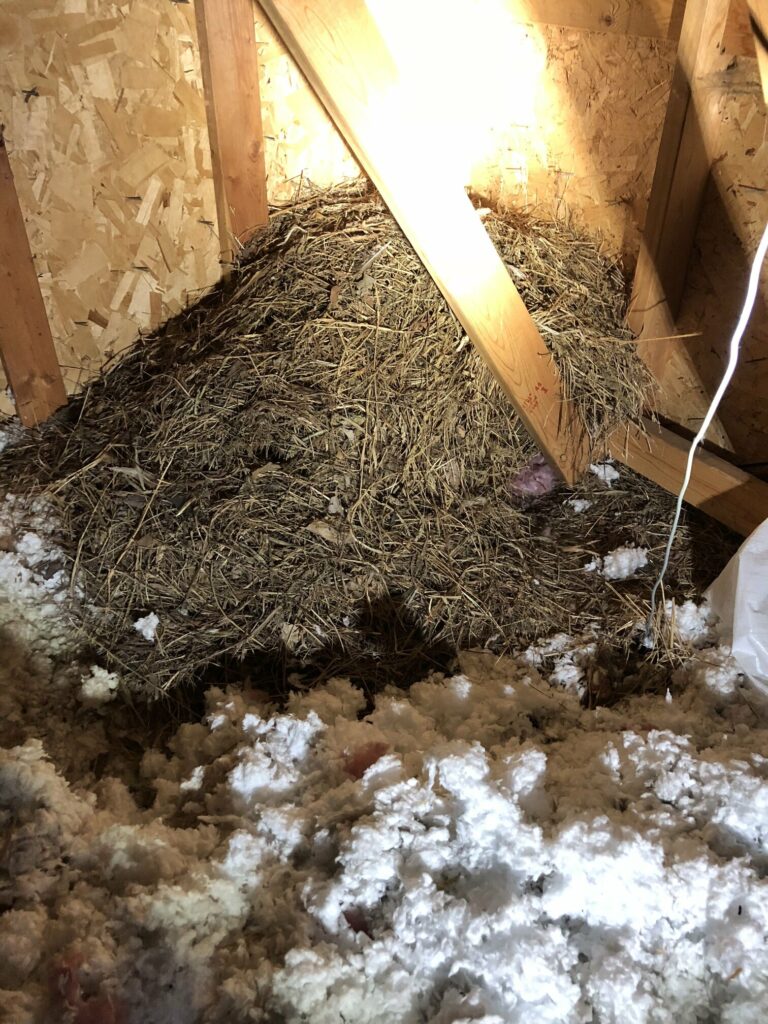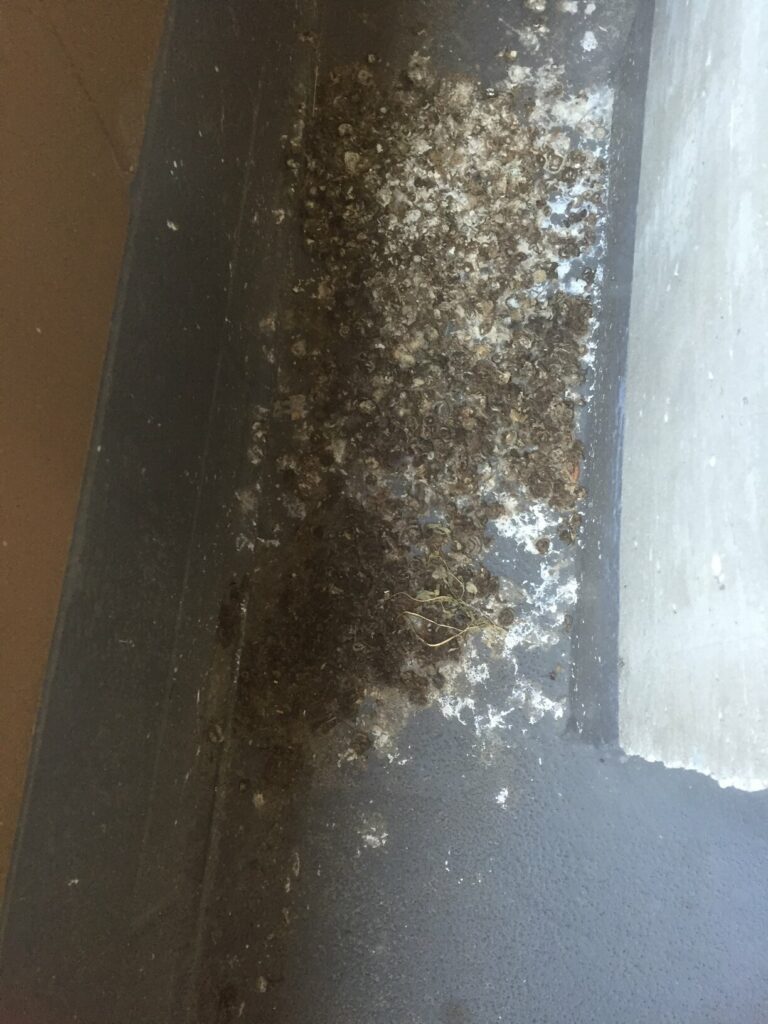
Bird infestations can prove more of a hazard than most people realize, as many carry more than 60 transmissible diseases . This list continues to grow, and is not exhaustive of all possible risks posed by pest animals.
Utilize proper PPE, follow laws, regulations, & recommended removal techniques. when removing, handling, or disturbing. bird nests, juveniles, eggs, droppings, & birds themselves.
Below are some of the most common issues.Allergic Alveolitus
Occurs when humans inhale particles of bird dander in the air. Also known as
“Pigeon Lung Disease,” this affects the alveoli if the lungs, decreasing the lungs’ ability to function & making it difficult to breathe.
Avian Influenza
Also known as “The Bird Flu” is the H5N1 virus which is transmitted through the
fecal matter of infected birds. This serious disease is able to live in objects such as bird feeders,
baths, and houses, as well as in birds themselves. This disease is well-known for being deadly in
humans, causing more severe symptoms than typical flu viruses including high fever, cough,
respiratory difficulties, and muscle aches.
Avian Tuberculosis
Is caused by inhaling microscopic organisms found in the feces of birds.
Potentially fatal, this disease is difficult to treat and symptoms include weight loss, swollen stomach, diarrhea, and impaired breathing.
Campylobacteriosis
Causes gastrointestinal distress, usually transmitted through food and water
that’s been contaminated by bird fecal matter. Symptoms include diarrhea, weight loss, and lethargy.
Candidiasis
Is a yeast or fungus infection spread by pigeons. The disease affects the intestines,
mouth, skin, urogenital tract, and the respiratory system.
Cryptococcosis
Is caused by yeast found in the intestinal tract of pigeons and starlings, usually passed by ingestion of infected fecal matter. This illness begins as a pulmonary disease & can advance to affect the central nervous system.

E.coli
Is generally spread via fecal contamination of food. Birds frequently peck on cow manure,
which is one place where E.coli 0157:7 originates. Infected birds are unaffected but spread the
bacteria into food and water supplies.
Erysipeloid
Is passed by direct contact between humans and birds. Broken skin is affected, which
changes from red to blue-red, and the infection can spread to joints.
Giardiasis
Is caused by an intestinal parasite Giardia found in contaminated food, causing diarrhea, weight loss, bloating, nausea, vomiting, and dehydration.
Histoplasmosis
Or “Ohio River Valley Fever” is transmitted when humans inhale the Histoplasma
capsulatum fungus that grows in dried bird and bat droppings. It is an extremely serious respiratory disease that can prove fatal, especially in those with compromised immune systems, including children.
Newcastle Disease
(or “Avian Pneumoencephalitis”) is passed orally through food contaminated
by infected bird fecal matter. The Newcastle disease virus causes flu-like symptoms, neurological dysfunction, seizures, conjunctivitis, and respiratory problems.
Pasteurellosis
Usually occurs when humans are bitten or scratched by birds infected by Pasteurella multocida organisms, though in some cases caused by inhalation via respiratory droplets. Scratches may become red and infected, while respiratory infection can result in bronchitis, pneumonia, or septicemia.
Psittacosis
Also known as “Parrot Fever,” “Ornithosis,” or “Chlamydiosis” occurs when the
C.psittaci bacterium passes to humans via inhalation, contact, or ingestion. This potentially lethal disease causes flulike symptoms in humans and can quickly escalate to pneumonia.
Q Fever
Is caused by Coxiella burnetii, a gram-negative pleomorphic bacillus that is passed in the feces of infected birds as well as other animals and ticks. Symptoms in humans include fever,
headache, pneumonitis, and photophobia.
Salmonellosis
Can be traced to the droppings of pigeons, starlings and sparrows. Most often dried waste bacteria is sucked through contaminated air conditioners or vents, contaminating the food and cooking surfaces of restaurants, food processing plants, and homes.
Sarcocystis
Is a parasitic infection transmitted by birds as well as contaminated water (though this is not yet certain), and is also carried by rats. Symptoms in infected humans include nausea,
diarrhea, and abdominal pain. Usually only lasting 48 hours or less, this infection can be life-
threatening, especially to the elderly and those with compromised immune systems.
St. Louis Encephalitis
Is spread by mosquitoes which have fed on pigeons, house sparrows and
finches carrying the Group B virus. The nervous system becomes inflamed, usually causing fever,
headache, & drowsiness. It can later result in coma, paralysis, or death. It is especially fatal to
persons over age 60.
West Nile Virus
(“West Nile Fever” or “West Nile Encephalitis”) is spread by mosquitoes that have
ted on infected wild birds. A potentially life-threatening infection that can cause weeks or months of illness.
Birds are Also Associated With Over 50 Kinds of Ectoparasites
Several bird ectoparasites, (a parasite that lives on the skin/exterior of a host) can easily transfer to humans, including:
Bed Bugs
(Cimex lectularius) are often found on pigeons, starlings, and house sparrows. Bed bugs draw blood from hosts including humans, and can consume up to 5 times their weight in blood. Infestations are common, especially in cities.
Chicken mites
(Dermanyssus gallinae) are known carriers of encephalitis and may also cause fowl mite dermatitis & acariasis. Chicken mites primarily feed on the blood of birds, but will often bite humans. They are commonly found on pigeons, starlings, and house sparrows.
Fleas
(Ceratophyllus gallinae & Dasypsyllus gallinule; “the bird flea”) spend little time on bird hosts but often infest nests and can easily transfer onto pets or humans. Bird fleas are a concern in hen houses and battery cages, and are known to rapidly reproduce in bird nests.
Fungi grows on decomposing skin (cellulose) & feathers (keratinophilic) of birds themselves,
shielded in the plumage barrier. Fungi also grows on bird nests and in bird droppings, and are
associated with many of the inhalation-contracted diseases noted above.
Ticks
Which bite/embed themselves onto humans, including larvae, nymphs and adults. Ticks can
transfer onto surfaces via bird feeders or wherever birds land. Deer ticks notably carry and transmit Lyme Disease, as well as other diseases humans can contract.
Lice
Of all kinds enjoy the barrier feathers create, some feeding on the feathers themselves. A
A variety of such lice also enjoy human skin and hair.
Yellow mealworms
Are likely the most common beetle parasites of people in the United States,
often infesting homes and biting humans in their larval form. These pests commonly live in pigeon nests and chicken coops, but their eggs may be passed on by carrier birds. These larvae often seek out human food sources, such as breakfast cereals, and if ingested may cause symptoms including intestinal canthariasis and hymenolepiasis.
In addition to diseases and ectoparasites, nests provide ideal shelter for many other insects.
Utilize proper PPE, follow laws, regulations, & recommended removal techniques ;
when removing, handling, or disturbing ;
bird nests, juveniles, eggs, droppings, & birds themselves.
